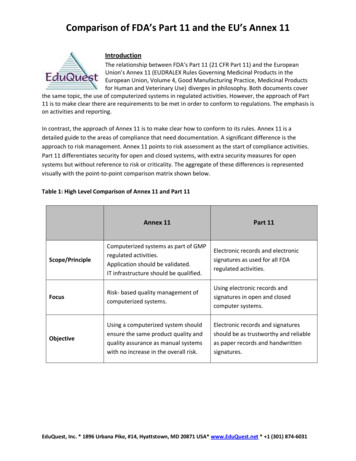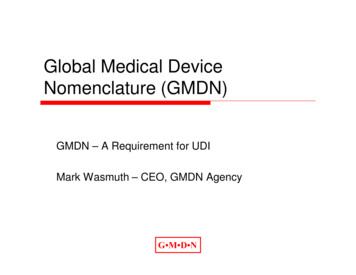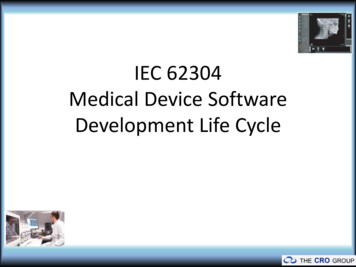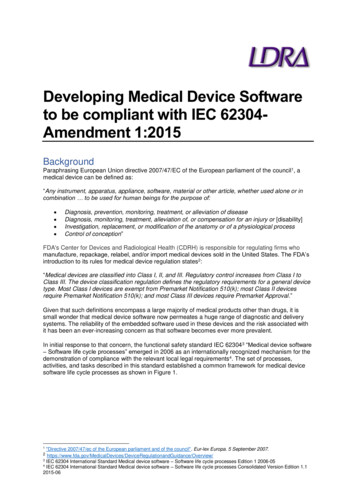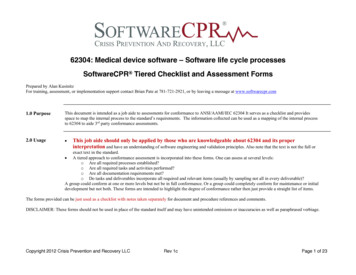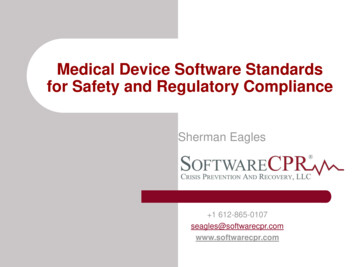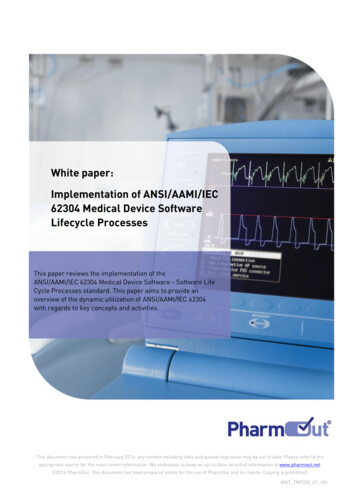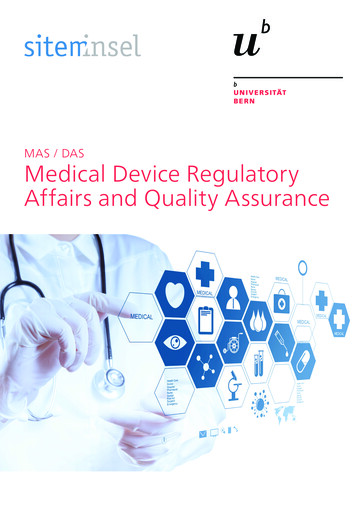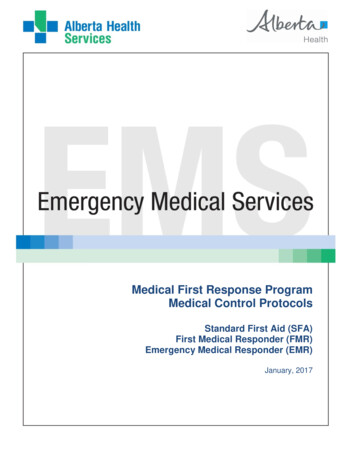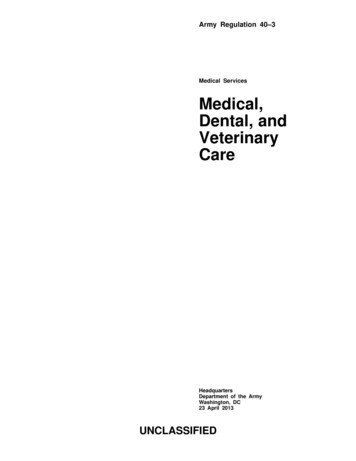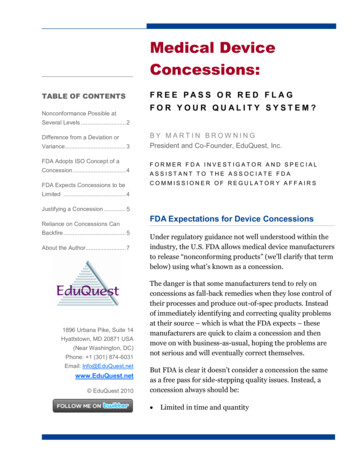
Transcription
Medical DeviceConcessions:TABLE OF CONTENTSNonconformance Possible atF R E E PAS S O R R E D F L A GFOR YOUR QUALITY SYSTEM?Several Levels . 2Difference from a Deviation orVariance. 3FDA Adopts ISO Concept of aConcession . 4FDA Expects Concessions to beBY MARTIN BROWNINGPresident and Co-Founder, EduQuest, Inc.FORMER FDA INVESTIGATOR AND SPECIALASSISTANT TO THE ASSOCIATE FDACOMMISSIONER OF REGULATORY AFFAIRSLimited . 4Justifying a Concession . 5Reliance on Concessions CanBackfire . 5About the Author . 71896 Urbana Pike, Suite 14Hyattstown, MD 20871 USA(Near Washington, DC)Phone: 1 (301) 874-6031Email: Info@EduQuest.netwww.EduQuest.net EduQuest 2010FDA Expectations for Device ConcessionsUnder regulatory guidance not well understood within theindustry, the U.S. FDA allows medical device manufacturersto release “nonconforming products” (we’ll clarify that termbelow) using what’s known as a concession.The danger is that some manufacturers tend to rely onconcessions as fall-back remedies when they lose control oftheir processes and produce out-of-spec products. Insteadof immediately identifying and correcting quality problemsat their source – which is what the FDA expects – thesemanufacturers are quick to claim a concession and thenmove on with business-as-usual, hoping the problems arenot serious and will eventually correct themselves.But FDA is clear it doesn’t consider a concession the sameas a free pass for side-stepping quality issues. Instead, aconcession always should be:Limited in time and quantity
Carefully controlledAppropriately authorizedWell documented, andClaimed after identifying the nonconformance.If not, FDA has instructed its investigators to regardconcessions as red flags signaling potential quality problemsworthy of further scrutiny and possible enforcement action.In FDA’s world, thephrase “specifiedrequirement”covers a multitudeof expectations.Nonconformance Possible at Several LevelsTo fully understand the concept of a concession, let’s startwith the definition of a nonconformance. You also need tounderstand that a nonconformance, deviation, and varianceare not the same thing, although the terms are sometimesused interchangeably in industry.According to both ISO 13485:2003 and 21 CFR Part 820(FDA’s Quality Systems Regulation), a nonconformanceis the failure to fulfill a specified requirement.Sounds simple enough, but in FDA’s world, the phrase“specified requirement” covers a multitude of expectationsand manufacturing levels, including requirements,specifications, and process parameters that are stated –explicitly and implicitly – by an organization, its customers,or other interested parties.A nonconformance, according to FDA, can be at the product,process or quality system level. A nonconforming productcould include a finished device, in-process device, devicecomponent, returned device, or specific manufacturingmaterial.So a nonconformance might include any or all of thefollowing:MEDICAL DEVICE CONCESSIONS: FREE PASS OR RED FLAG?WWW.EDUQUEST.NET2
SIDEBAR 1:ISO 9001:2000DEFINITIONSFailing to meet a design specificationNot following a standard procedureFailing to control a validated process parameter3.6.2 nonconformity: A non-fulfillment ofa requirement.3.6.11 concession: Permission to use orrelease a product that does not conform tospecified requirements.Ignoring a customer’s written requirements, orMissing test limits – or not testing at all – just to name afew examples.NOTE: A concession is generally limited tothe delivery of a product that has nonconforming characteristics within specifiedDifference from a Deviation or Variancelimits for an agreed time or quantity of thatproduct.3.6.12 deviation permit: Permission todepart from the originally specified requirements of a product prior to realization.NOTE: A deviation permit is generallygiven for a limited quantity of product orperiod of time, and for a specific use.Many people confuse a nonconformance with a deviation orvariation, but they differ by an important degree of timingand intent. Deviations are issued prior to performing theoperation and not in response to a nonconformance ornonconforming activity. ISO 9001:2000 provides adefinition for a “deviation permit” that allows release priorto what it calls “product realization” (see Sidebar 1).Deviations should be reviewed and approved in advance ofthe action to be deviated from – such as a purchasingdecision, manufacturing change, or other operation underthe quality system. An authorized signature, date, andwritten justification are required for each approveddeviation.Instead of the term deviation, FDA uses a similar conceptand calls it an “approved variance”. As described in 21 CFR820.1(e)(2), FDA can grant a variance from any devicequality system requirement when the Agency determines thevariance is in the best interest of public health. Amanufacturer can seek a variance by petitioning FDA inadvance of the activity, or the Agency itself can initiate avariance in response to a specific public health need.MEDICAL DEVICE CONCESSIONS: FREE PASS OR RED FLAG?WWW.EDUQUEST.NET3
SIDEBAR 2:FROM THE PREAMBLETO 21 CFR PART 820,COMMENT 156:156. FDA has rewritten § 820.90(b)(1),‘‘Nonconformity review and disposition,’’ toFDA Adopts ISO Concept of a ConcessionNow we can move on to concessions. FDA has no officialdefinition of a concession, but in the preamble to 21 CFRPart 820 the Agency says it doesn’t define terms it thinks areadequately covered by ISO standards or generally knownwithin the industry.make clear that the section requires procedures that define the responsibility forreview and authority for disposition ofnonconforming product and that set forththe review and disposition process. FDAbelieves that proper disposition of nonconforming product is essential for ensuringthe safety and effectiveness of devices.Manufacturers have made determinationsthat nonconforming product may be usedwhich have resulted in defective devicesbeing distributed. Thus, although it may beappropriate at times to use nonconformingproducts, the disposition process must beadequately controlled.The revision requires that disposition andjustification for concessions be documented. FDA believes that the justificationThe ISO standards define a concession as a means ofreleasing product for further manufacturing or commercialuse, even when the product doesn’t conform to a preestablished requirement or specification (or the process bywhich it was manufactured doesn’t conform).Like an ISO deviation or an FDA approved variance, theconcession process is limited by time and condition. Notealso that a concession is issued after the finding of anonconformance. And similar to a deviation or variance, aconcession must be reviewed and approved prior to releaseof the product. Again, authorized signatures and dates arerequired – as is the justification for each concession (seeSidebar 2).should be based on scientific evidence,which a manufacturer should be preparedto provide upon request. Concessionsshould be closely monitored and notbecome accepted practice. [Editor’semphasis added] This section is consistent with ISO 9001:1994, section 4.13.2.Several comments on the Working Draftstated that the term ‘‘concession’’ shouldbe deleted because it is confusing. FDAhas rewritten the sentence to ensure themeaning of this requirement is clear. Thesentence now reads, ‘‘Documentation shallinclude the justification for the use of non-FDA Expects Concessions to be LimitedIn the FDA Guide to Inspections of Medical DeviceManufacturers (see Sidebar 3), the Agency says itexpects concessions to be the exception, not the rule. If amanufacturer evaluates and releases one product lot, batchor shipment “on concession”, FDA expects the company willnot treat the next product lot, batch or shipment similarly.Instead, FDA expects the manufacturer to make some kindof change to correct the nonconformity from re-occurring.conforming product and the signature ofthe individual(s) authorizing the use.’’The expected change could be to the product design, themanufacturing process or the acceptance criteria, to cite justa few examples. Furthermore, the change should beMEDICAL DEVICE CONCESSIONS: FREE PASS OR RED FLAG?WWW.EDUQUEST.NET4
SIDEBAR 3:FROM THE FDA GUIDETO INSPECTIONS OFMEDICAL DEVICEMANUFACTURERSNonconformity Review and Disposition - 21 CFR 820.90(b)(1)Review all records for the proper disposi-documented, scientifically justified and verified, andvalidated as appropriate.No matter what the change, FDA insists that before theproduct can be released into the marketplace, it still must:Meet all essential outputs, andBe safe and effective for its labeled and known intendeduses.tion of nonconforming products for assurance that use of nonconforming producthas not resulted in the distribution of defective devices. The distribution and justification for concessions (allowance to useotherwise nonconforming product, oftendone through a Material Review Board)must be documented and based on scientific evidence. Concessions should beclosely monitored and not becomenormal practice. [Editor’s emphasisadded]Deficiencies would include a lack of scientific evidence for justification of the concession. If a concession resulted in a changeJustifying a ConcessionDocumentation and justification are essential to support aconcession claim. If you have data from any design controleffort that establishes the safety and efficacy of the productdespite the specified nonconformance, show it. For validatedprocesses, the nonconformance may be acceptable if it fallswithin the validated range, even if outside the operating oroptimized range. However, always be prepared todemonstrate that a process-related nonconformance doesn’tadversely impact the safety and efficacy of the product.of product specifications (form, fit or function), the change should be evaluated forpossible 510(k) submission. At a minimum,a risk analysis should always be considered for any changes.Even with a concession, you still must meet all 510(k) andPMA requirements. If a product or its manufacturingprocess fails to comply with those activities approved in a510(k) or PMA, you may need to seek a new, cleared 510(k)or an approved PMA supplement prior to release of theproduct. For some 510(k)s, you may need only to change theproduct’s intended uses. For a class II or III 510(k), yourchange must specify any special controls you’re adding oralterations you’re making to the manufacturing process.Reliance on Concessions Can BackfireAlthough the concept of a medical device concession mayseem like a loophole in the quality regulations, in reality aMEDICAL DEVICE CONCESSIONS: FREE PASS OR RED FLAG?WWW.EDUQUEST.NET5
company with a large volume of concessions is waving a redflag to regulators and its customers. You may as well signal“we don’t have adequate control over our products orprocesses”.FDA equatesfrequentconcessions withpoor productdesign, transfer,manufacturing,and monitoring.FDA equates frequent concessions with poor product design,poor design transfer, poor manufacturing processes, poormonitoring – or a toxic combination of all the above.Overuse of concessions also may indicate the likelihood youhave a poor vendor/supplier management process, whichhas become one of the FDA’s top enforcement targets.FDA has given explicit instructions to its inspectors to lookfor abuses to the concession process. To meet the QualitySystems Regulation as well as ISO standards, you need tokeep your concessions on a short leash, limiting them to verynarrow nonconformance conditions and supporting themwith thorough scientific justifications and properauthorizations.Otherwise, your presumed free pass may just earn you a 483,Warning Letter, product recall, or worse.For Additional Information:EduQuest offers an eight-hour training class on QSRCompliance Fundamentals: Complying with FDA’sMedical Device 21 CFR 820 Quality SystemsRegulation. The course is available on-demand at your siteand presented nationally as an open enrollment class severaltimes each year. The class also can be accompanied by a 16hour class on Medical Device Design Control, a frequentsource of concessions when not handled properly. ContactMartin Heavner at MartinHeavner@EduQuest.net or visitwww.EduQuest.net for course outlines and pricing.MEDICAL DEVICE CONCESSIONS: FREE PASS OR RED FLAG?WWW.EDUQUEST.NET6
About the Author:Martin Browning is the President and Co-Founder ofEduQuest, Inc., a global team of FDA compliance expertsbased near Washington, D.C.M ARTIN BROWNINGPresident and Co-FounderEduQuest, Inc.He has more than 30 years of regulatory experience at theFDA and as a highly sought-after advisor to industry.Martin’s 22-year career at FDA included work in the fieldoffices as an investigator and as a senior manager in theOffice of Regulatory Affairs at FDA headquarters. He cappedhis FDA career by serving as a special assistant to theAssociate Commissioner for Regulatory Affairs. He alsoserved as vice chair of FDA’s electronic record and signatureworking group, where he helped draft the original 21 CFRPart 11 regulations. In addition, Martin served as the chair ofthe U.S. government’s ISO 9000 committee and was amember of the FDA committee that developed the medicaldevice Quality Systems Regulation (QSR).At EduQuest, which has been serving medical device,pharmaceutical, biologics companies since 1995, Martinhelps clients solve problems related to FDA regulation,quality assurance, software and systems engineering, andcompliance auditing, including assessing vendors andoutsourced operations.1896 Urbana Pike, Suite 14Hyattstown, MD 20871 USA(Near Washington, DC)Phone: 1 (301) 874-6031Fax: 1 (301) 874-6033Email: Info@EduQuest.netwww.EduQuest.net EduQuest 2010
According to both ISO 13485:2003 and 21 CFR Part 820 (FDA’s Quality Systems Regulation), a nonconformance is the failure to fulfill a specified requirement. Sounds simple enough, but in FDA’s world, the phrase “specified requirement” covers a multitude of expec
